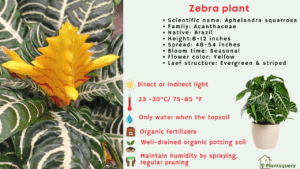Introduction
The Zebra plant (Aphelandra squarrosa) is a beautiful woody broadleaf evergreen shrub native to the tropical forests of Brazil. It belongs to the family Acanthaceae. This plant can be grown indoors as well as outdoors. Zebra plants are valued for their green shiny emerald color foliage with attractive white veins which gives it a zebra skin-like appearance. These plants attain a good height in their wild environment but as house plants, they reach a normal height of up to 7 inches. The following article is all about how to take care of the zebra plant and the common problems faced while growing this plant.
Botanical description
Plant height
8-12 inches tall
Leaf appearance
Elliptical or entire; 6-9-inch-long and 3-4-inch-wide with pointed tips (book)
Flower
Bright yellow on the fleshy terminal spikes of waxy inflorescence (3). Flower spikes reach 8 inches in length and last for 6 weeks.
It requires 4 hours of direct sunlight or bright indirect light and hence needs an average well-lighted area. Generally, as a tropical plant, it grows well under hot and dry conditions (1).
The zebra plant is not only a gorgeous woody houseplant but this plant shows many pharmaceutical activities. The leaves of this plant showed strong antibacterial activity against E. coli. Because of its medicinal properties, this plant is traditionally used in the treatment of a variety of conditions ranging from poisonous bites, fever, headache, vertigo, and wounds (2).

How to take care of zebra plant
care for zebra plants can be done mainly by checking the temperature, light, and water conditions. Proper potting, and humidity are essential for the healthy growth of the plant.
Light requirement
Bright direct or indirect light for a minimum of 3- 4 hours
Temperature
As this plant is tropical in nature, therefore, requires 23 -30°C/ 75-85 °F degrees Celsius.
Water
Only water when the topsoil becomes dry. Although take care that the plant requires humidity hence do not let the plant dry.
Humidity
As this plant is basically tropical in nature hence requires high humidity to grow well. Therefore make sure that the plants get enough humidity by either mist or the bottom of the pot sits indirectly in the water plate.
Potting and repotting medium
Well-drained organic potting soil with organic fertilizers helps the plants to thrive healthily. Too many fertilizers are also not good for these plants.
Propagation
Through stem tip cutting
Pruning
After the flower dried up, cut the flower with the leaf and base below it. Leave only two to three rows of leaves for the healthy growth of the plant to the subsequent years.
Pet Friendly
The zebra plant is non-toxic to cats and dogs.
Common problems and how to take care (3).
1. Ripple leaf
High temperature may be the reason behind the ripple leaf. Change in the environment helps to overcome the ripple leaf.
2. Crinkle leaf
This disorder is mostly seen under high light and high temperatures. The leaves started to crinkle with reduced size, short internode, and axillary bud proliferation.
3. Moisture stress
Leaf or the tip of the leaf collapse. Water frequently and reduce excess fertilization.
4. Leaf drop
Due to less moisture and dry air or low humidity, this kind of problem happens. Maintain moisture and humidity as these plants are tropical plants in origin.
Fungal problems
Common fungal problems are Botrytis blight, Corynespora leaf spot, and Myrothecium leaf spot. Symptoms of these fungal issues are mainly leaf spots at the leaf edge which are contacting with the potting medium. Botrytis blight causes dusty gray-tan spores, Corynespora leaf spot, and Myrothecium leaf spot dark brown or black wet spot only late having the presence of fungal fruiting underside of the pan.
Insect problems
Aphids, and caterpillars both can be removed manually, and fungus gnats and mealybugs reduce watering and try to clean regularly.
Q&A
